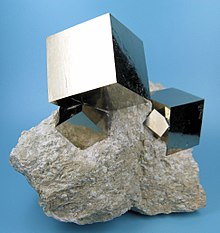
Back Piriet Afrikaans Pirita AN بيريت Arabic Pirita AST ХъинцӀир AV Pirit Azerbaijani Пирит Bashkir Пірыт Byelorussian Пирит Bulgarian Pirit (mineral) BS
| Pyrite | |
|---|---|
 Intergrowth of lustrous, cubic crystals of pyrite, with some surfaces showing characteristic striations, from Huanzala mine, Ancash, Peru. Specimen size: 7.0 × 5.0 × 2.5 cm | |
| General | |
| Category | Sulfide mineral |
| Formula (repeating unit) | FeS2 |
| IMA symbol | Py[1] |
| Strunz classification | 2.EB.05a |
| Dana classification | 2.12.1.1 |
| Crystal system | Cubic |
| Crystal class | Diploidal (m3) H-M symbol: (2/m 3) |
| Space group | Pa3 |
| Unit cell | a = 5.417 Å, Z = 4 |
| Identification | |
| Formula mass | 119.98 g/mol |
| Color | Pale brass-yellow reflective; tarnishes darker and iridescent |
| Crystal habit | Cubic, faces may be striated, but also frequently octahedral and pyritohedral. Often inter-grown, massive, radiated, granular, globular, and stalactitic. |
| Twinning | Penetration and contact twinning |
| Cleavage | Indistinct on {001}; partings on {011} and {111} |
| Fracture | Very uneven, sometimes conchoidal |
| Tenacity | Brittle |
| Mohs scale hardness | 6–6.5 |
| Luster | Metallic, glistening |
| Streak | Greenish-black to brownish-black |
| Diaphaneity | Opaque |
| Specific gravity | 4.95–5.10 |
| Density | 4.8–5 g/cm3 |
| Fusibility | 2.5–3 to a magnetic globule |
| Solubility | Insoluble in water |
| Other characteristics | paramagnetic |
| References | [2][3][4][5] |
The mineral pyrite (/ˈpaɪraɪt/ PY-ryte),[6] or iron pyrite, also known as fool's gold, is an iron sulfide with the chemical formula FeS2 (iron (II) disulfide). Pyrite is the most abundant sulfide mineral.[7]

Pyrite's metallic luster and pale brass-yellow hue give it a superficial resemblance to gold, hence the well-known nickname of fool's gold. The color has also led to the nicknames brass, brazzle, and brazil, primarily used to refer to pyrite found in coal.[8][9]
The name pyrite is derived from the Greek πυρίτης λίθος (pyritēs lithos), 'stone or mineral which strikes fire',[10] in turn from πῦρ (pŷr), 'fire'.[11] In ancient Roman times, this name was applied to several types of stone that would create sparks when struck against steel; Pliny the Elder described one of them as being brassy, almost certainly a reference to what is now called pyrite.[12]
By Georgius Agricola's time, c. 1550, the term had become a generic term for all of the sulfide minerals.[13]

Pyrite is usually found associated with other sulfides or oxides in quartz veins, sedimentary rock, and metamorphic rock, as well as in coal beds and as a replacement mineral in fossils, but has also been identified in the sclerites of scaly-foot gastropods.[14] Despite being nicknamed "fool's gold", pyrite is sometimes found in association with small quantities of gold. A substantial proportion of the gold is "invisible gold" incorporated into the pyrite (see Carlin-type gold deposit). It has been suggested that the presence of both gold and arsenic is a case of coupled substitution but as of 1997 the chemical state of the gold remained controversial.[15]
- ^ Warr, L.N. (2021). "IMA–CNMNC approved mineral symbols". Mineralogical Magazine. 85 (3): 291–320. Bibcode:2021MinM...85..291W. doi:10.1180/mgm.2021.43. S2CID 235729616.
- ^ Hurlbut, Cornelius S.; Klein, Cornelis (1985). Manual of Mineralogy (20th ed.). New York, NY: John Wiley and Sons. pp. 285–286. ISBN 978-0-471-80580-9.
- ^ "Pyrite". Webmineral.com. Retrieved 2011-05-25.
- ^ "Pyrite". Mindat.org. Retrieved 2011-05-25.
- ^ Anthony, John W.; Bideaux, Richard A.; Bladh, Kenneth W.; Nichols, Monte C., eds. (1990). "Pyrite" (PDF). Handbook of Mineralogy. Vol. I (Elements, Sulfides, Sulfosalts). Chantilly, Virginia, US: Mineralogical Society of America. ISBN 978-0962209734.
- ^ "Pyrite | meaning in the Cambridge English Dictionary". dictionary.cambridge.org.
- ^ Vernon J. Hurst; Thomas J. Crawford (1970). Sulfide Deposits in the Coosa Valley Area, Georgia. Economic Development Administration, Technical Assistance Project, U. S. Department of Commerce. p. 137.
- ^ Jackson, Julia A.; Mehl, James; Neuendorf, Klaus (2005). Glossary of Geology. American Geological Institute. p. 82. ISBN 9780922152766 – via Google Books.
- ^ Fay, Albert H. (1920). A Glossary of the Mining and Mineral Industry. United States Bureau of Mines. pp. 103–104 – via Google Books.
- ^ πυρίτης. Liddell, Henry George; Scott, Robert; A Greek–English Lexicon at the Perseus Project.
- ^ πῦρ in Liddell and Scott.
- ^ Dana, James Dwight; Dana, Edward Salisbury (1911). Descriptive Mineralogy (6th ed.). New York: Wiley. p. 86.
- ^ "De re metallica". The Mining Magazine. Translated by Hoover, H.C.; Hoover, L.H. London: Dover. 1950 [1912]. see footnote on p 112.
- ^ "Armor-plated snail discovered in deep sea". news.nationalgeographic.com. Washington, DC: National Geographic Society. Archived from the original on November 10, 2003. Retrieved 2016-08-29.
- ^ Fleet, M. E.; Mumin, A. Hamid (1997). "Gold-bearing arsenian pyrite and marcasite and arsenopyrite from Carlin Trend gold deposits and laboratory synthesis" (PDF). American Mineralogist. 82 (1–2): 182–193. Bibcode:1997AmMin..82..182F. doi:10.2138/am-1997-1-220. S2CID 55899431.
© MMXXIII Rich X Search. We shall prevail. All rights reserved. Rich X Search